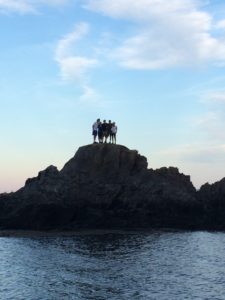I arrived to relieve Dr. Johan Erikson in our tag-team stewardship of the intrepid ESS student group on Wednesday September 10th, finding a group that was well into relaxation mode, after a full session of geology and sprint to the finish with a paper and final exam. Nothing like a beautiful day at the beach to recharge the batteries. However…… The ensuing day we were back out to perform a beach profile of the dynamic Popham Beach face. The afternoon was all about waves and tides, and now we all can recognize spilling, plunging, and surging breakers, and relate them to the beach slopes we measured in the morning.
As sure as the sun rises, we are moving back into field exercises and experiential learning. As I stated to the students, my ulterior motive is to ruin them for ever going to a beach and just enjoying the beautiful scenery, letting the mind empty. Rather, I would have their minds be restless, constantly looking at patterns, asking “what processes could have produced that pattern in the sand? Why do the shorebirds only seem to forage at the low tide mark, and what are they eating? How did those air holes form in the upper intertidal?” Then, if I’ve done my job well, they’ll think of an explanation, and ask themselves “How might I test whether my explanation is correct?”
Over the next two days they explored the various nooks and crannies of the sandy beach ecosystem, looked for organisms, and strove to correlate organism distribution with the physical forces that shape the beach ecosystem. That, and a good deal of cooking and eating, enjoying social time, trying to get the measure of the new guy, and transitioning to the ecological perspective. In the first few weeks, they have clearly evolved into a well-oiled machine of meal preparation and community living – most impressive. It’s also wonderful to see the “collateral learning”, such as “bad idea to pour the corn/cream/melted cheese leftovers down the drain when there’s no garbage disposal.” Thankfully there’s no predicament that seems to be beyond Bobby Michaud’s capacity to solve.
















